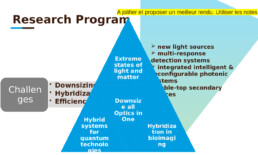Context
The GPR LIGHT is an ambitious research program in the field of light sciences and applications. The GPR that is part of the overall quest for :
New alternative energies, such as the development of new methods for efficient and low-cost exploitation of solar energy; and of a new generation of power plants based on laser-initiated nuclear fusion reactions
Development of the smart cities and industries 4.0
New information technologies especially those based on quantum mechanics laws
Cost-effective methods of diagnosis & therapy e.g. for personalized medicine
All these challenges require the emergence of :
New light sources (higher powers, wider spectral ranges, faster tunability or of a quantum nature)
New multi-response detectors and detection systems
New integrated, intelligent and reconfigurable devices based on hybrid solutions
We are currently at the confluence of two revolutions: the photonic revolution, and the second quantum revolution.
As current technologies are pushed to the limits of speed, capacity and precision, photonics and quantum technologies offer breakthrough solutions.
Challenges and Ambition
Our GPR will address 3 major scientific challenges, to bring photonics and quantum technologies to the level of integration :
Scientific challenges
- Downsizing/downscaling to facilitate integration in various environments
- Optimizing the efficiencies and performance of light emitting, detecting and switching devices at all scales from single molecules to large systems
- Developing light based strategies combining/Hybridizing several materials, functions and/or modalities
The combination of imaging modalities will open a new era for understanding biological processes in unprecedented detail and for designing tomorrow’s solutions.
Our ambition is to amplify the dynamics initiated by our community to :
- Promote high-impact research in light sciences and applications
- Place Bordeaux campus at the forefront of international excellence
Research Program

The program is structured around four research thrusts, from which ambitious collaborative 8 years projects emanate that aim to address the three major scientific challenges which are transversal to the axes and necessary to bring the technologies to the level of integration.
Thrust 1 : Extreme states of light and matter
Light matter interactions in the extreme regimes.
- Develop highly efficient miniaturized radiation and ion beam sources
- Drive matter to extreme states of density and temperature
- Creates very large electric and magnetic fields in plasmas
- Application in plasma physics, nuclear physics, laboratory astrophysics
Bordeaux research groups have an international leadership in the fields of structured light, high energy radiation sources, laser plasma acceleration, and high energy density science.
Thrust 2 : Hybrid systems for quantum technologies
- New hybrid nano-mechanics quantum systems in the quantum regime
- Collective effects in superstructure of quantum emitters
- Interplay nanooptics, magnetism and macroscopic quantum states
- Cold atoms in photonic structures for sensing and quantum simulations
Teams involved in this axis have internationally recognized expertise in cold atom physics, nanophotonics, single nano-objects spectroscopy, superconductivity and nano-opto-mechanics
Thrust 3 : Downsize all Optics in One
Highly interdisciplinary approaches combining elaboration of new materials & implementation of innovative approaches for volume and surface structuring of optical contrasts :
- Advanced Materials for IR Photonics
- Hybrid chemically active surfaces for photonics functions
- Integrated photonic components and systems for light generation, processing and detection operating in the visible, near-IR or med-IR
The strong chemistry and materials science community has a long-standing synergistic collaborations with physicists for lasers and photonics applications.
Thrust 4 : Hybridization in biophotonics and imaging: revealing the ultrastructures and understanding the functions
Combination of cutting-edge imaging technologies :
- Super-resolution fluorescence microscopy with cryo-electron microscopy to enable revolutions in both the determination of biomolecules atomic structure and the understanding of their function in their natural contexts
- label-free optical imaging with Fluorescence nanoscopies To provide context information necessary to address the challenge of quantification
This axis gathers internationally renowned teams with complementary expertise covering all critical aspects of the technologies.